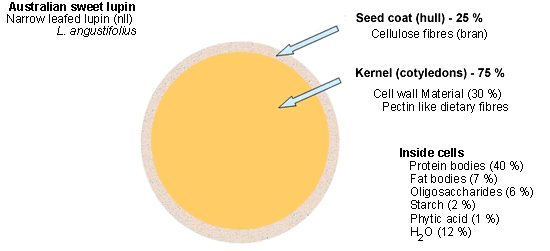Introduction
Since use of processed animal proteins in non-ruminant animal feeds banned by the European commission in December 2000, there is an increasing interest in use of legume seeds, particularly lupins, which has potential to reduce the cost of diets while maintaining production efficiency. Lupins are a valuable source of protein that can partially replace traditional proteins such as meat meal, fish meal and soybean meal. Three major cultivated species of lupins (Lupinus spp.) used in animal feeding are white lupin (L albus L.), narrow-leafed lupin or Australian sweet lupin (L angustifolius L.) and yellow lupin (L luteus L.). Use of white lupins is not recommended in pigs due to significantly increased retention time in the gastrointestinal tract and hence decreased feed intake when more than 150g/kg of white lupins are included. Australian sweet lupins and yellow lupins have been successfully used as protein replacements in diets for pigs.

Chemical/nutritional characteristics
Australian sweet lupins are a predominant protein source in Australian pig diets due to economic rationale as opposed to soybean meal (SBM) which is commonly used in most other countries. Despite the economic advantage, the use of lupins in diets for pigs has been restricted to less than 250 g/kg for growers and 300 g/kg for finisher/pre-sale pigs because of the concerns that:
(1) Anti-nutritional factors in lupins (eg, oligosaccharides, alkaloids and non-starch polysaccharides, NSP) are detrimental to pigs and;However recent review of research publications during the last decade indicates that:
(2) High NSP contents both in hull and kernel reduce energy utilisation efficiency (high in fermentable energy and low in NE, see Figure 1);
(3) Lupins contain inferior amino acid patterns compared with SBM (low lysine and sulphur amino acids);
(4) Pigs fed diets with a higher lupin concentration have a lower dressing percentage due to increased gut growth.
(1) Lupins contain inferior amino acid patterns (low lysine and sulphur amino acids) compared with SBM;Possibly, this means that grower/finisher pigs can handle the anti-nutritional factors in diets containing more than 300 g/kg lupins. In addition, attaining the right amino acid balance is crucial for better feed conversion than limiting the concentration of anti-nutritional factors in diets for pigs.
(2) However, lupins contain similar levels of oligosaccharides to SBM, and greater proportion of lupin NSP is from the hulls which have minimal anti-nutritive effect;
(3) Alkaloid levels, which cause a reduction in feed intake, are low enough in recent varieties of Australian sweet lupins; and
(4) The performance reduction in pigs fed lupin containing diets occurred mostly when the lupins replaced for SBM without adjustment for the shortage of amino acids.
Figure 1. Schematic diagram of Australian sweet lupins.

Concentration of Australian sweet lupins in pig diets
Experiment
Based on this knowledge, an experiment was conducted in Western Australia to determine whether replacing SBM with lupins up to 350 g/kg in diets for grower/finisher pigs are detrimental in terms of growth performance, carcass composition and meat quality traits. Group housed male pigs weighing 27.2 kg (n=112) were fed diets containing either 200 g, 250 g, 300 g or 350 g/kg lupins. Lupins were progressively substituted for SBM with adjustments of equal amounts of ileal digestible amino acids and ileal digestible lysine to DE ratio by supplementing synthetic amino acids. At approximately 107 kg live weight, the pigs were slaughtered and carcass composition and meat quality traits were measured.
Results
1. Dietary inclusion of up to 350 g lupins per kg grower, finisher and pre-sale diets did not depress growth performance of pigs in any stage.
2. Consequently, the days to reach 107 kg were similar regardless of the lupin concentration in the experimental diets.
3. A simple mix of wheat, barley and lupins with essential amino acid supplements supported daily gain of over 1 kg with an FCR of 2.7 kg/kg between 27 to 107 kg live weights without showing deleterious effects.
4. Also, increasing lupin concentrations up to 350 g/kg did not alter carcass composition and meat quality traits.
Yellow lupin study
However, another study with 6 kg weaner pigs fed diets containing varying levels of yellow lupins showed that feeding a diet containing more than 150 g/kg yellow lupins decreased performance of piglets. Feeding a diet containing up to 260 g/kg of the same yellow lupins to grow/finish pigs did not impair growth performance. Therefore, use of lupins in weaner diet should be limited to 150 g/kg.




